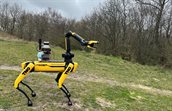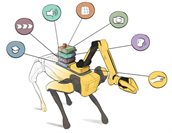Stackable for robotics
Robots can already do a lot, but they’re still quite dumb and invariably need humans to control them remotely. Adding intelligence to the system can enable a robot to recognise situations – including risky situations – autonomously, navigate, move objects by itself, and even work out what measures are needed in specific circumstances. TNO shows what is possible.

Difficult tasks in complex circumstances
The Boston Dynamics robot running on the roof was equipped with several modules by TNO. These comprise a database full of knowledge, a planning module, navigation, a camera, a microphone, a sound sensor, and a speaker. It turns the 'dumb' robot into an autonomous system that can perform difficult tasks by itself in complex environments and situations that are undesirable or virtually impossible for humans. This can assist rescue operations or facilitate inspections of industrial complexes. Numerous applications can also be imagined for the police and the armed forces. What TNO has now demonstrated is also useful for other autonomous systems, such as drones or vehicles.

Unexpected situations
TNO has shown what the SNOW robot (safe autonomous systems in an open world) is capable of in industrial inspections. It walks along pipelines and sees or hears whether there is a leak. With the knowledge on board, it can detect anomalies in the complex and decide to remove a suspicious object or sound the alarm. Being able to deal with unexpected situations and act appropriately is characteristic of the system.
Dangerous conditions
In rescue operations, the robot can perform tasks that are impossible for teams with dogs. Apart from the ability to see and hear very well, the ability to detect smells is also a possible addition to the system. The robot can enter buildings that are too dangerous for emergency services. The manufacturer provides a robot that is heat- and shock-resistant, for example, and TNO adds intelligence to enable it to perform complex tasks.

Combining AI and data communication
The technology developed therefore goes far beyond being able to detect objects and situations. The use of artificial intelligence (AI) and on-board data communication makes it possible to take decisions and perform actions at lightning speed. The modular approach allows the robot to be equipped with the capabilities for specific operations. Over the longer term, TNO foresees collaboration with other systems, such as drones or vehicles.
Could stackable for robotics technology benefit your market position? Contact us for investment and/or development opportunities.
